需求规约模板(System Requirement Specification)
CDIO需求规约说明书模板(最新版)

X系统软件需求规约说明书福建师范大学软件学院2010年11月目录1简介 (3)1.1目的 (3)1.2范围 (3)1.3定义、首字母缩写词和缩略语 (3)1.4参考资料 (4)2项目概述 (5)2.1产品功能 (5)2.3用户特点 (5)2.4运行环境 (5)2.5一般约束 (5)2.6假设和依据 (5)3功能需求 (5)(此为样例) (5)3.1选题子系统(二等标题字体黑体小三) (5)3.1.1选题子系统概述(三等标题字体黑体小四加粗) (5)3.1.2 UC0101提交课题审核表用例 (7)3.1.3 UC0102评审课题用例 (9)3.1.4 UC0103审批课题用例 (9)3.1.5 UC0104发布课题用例 (9)3.1.6 UC0105浏览课题用例 (9)3.1.7 UC0106选题用例 (9)3.1.8 UC0107选择课题成员用例 (9)3.1.9 UC0108指派课题成员用例 (9)3.1.10 UC0109发布选题结果用例 (9)3.1.11 UC01010浏览选题结果用例 (9)4非功能需求 (10)4.1安全性 (10)4.2易用性 (10)4.3可靠性 (10)4.4性能 (10)4.5可维护性、可扩展性和适应性 (10)1简介(正文字体宋体小四由PMO统一给出,不用填写) 1.1目的(正文字体宋体小四由PMO统一给出,不用填写) 1.2范围(正文字体宋体小四由PMO统一给出,不用填写) 1.3定义、首字母缩写词和缩略语本文档出现的缩略词(正文字体宋体小四由PMO统一给出,不用填写)本文档出现的术语1.4参考资料(正文字体宋体小四由PMO统一给出,不用填写)2项目概述(正文字体宋体小四由PMO统一给出,不用填写)2.1产品功能(正文字体宋体小四由PMO统一给出,不用填写)2.3用户特点(正文字体宋体小四由PMO统一给出,不用填写)2.4运行环境(正文字体宋体小四由PMO统一给出,不用填写)2.5一般约束(正文字体宋体小四由PMO统一给出,不用填写)2.6假设和依据(正文字体宋体小四由PMO统一给出,不用填写)3功能需求(一等标题字体黑体三号加粗)(此为样例要求有用例图用例词汇表,界面原型及用例场景) 3.1选题子系统(二等标题字体黑体小三)3.1.1选题子系统概述(三等标题字体黑体小四加粗)(1)用例图(四等标题字体黑体小四加粗)(正文字体宋体小四)图3.1-1 选题子系统用例图(2)用例概述3.1.2 UC0101提交课题审核表用例(1)界面原型图3.1-2提交课题审核表用例的界面原型(2)用例场景(涉及多个界面或界面交互复杂时填写)(3)活动图(涉及多个界面或界面交互复杂时填写,下面的图只是一个占位符)图3.1-3提交课题审核表用例的活动图3.1.3 UC0102评审课题用例3.1.4 UC0103审批课题用例3.1.5 UC0104发布课题用例3.1.6 UC0105浏览课题用例3.1.7 UC0106选题用例3.1.8 UC0107选择课题成员用例3.1.9 UC0108指派课题成员用例3.1.10 UC0109发布选题结果用例3.1.11 UC01010浏览选题结果用例………4非功能需求4.1 安全性(三等标题字体黑体小四)4.2 易用性(三等标题字体黑体小四)4.3 可靠性(三等标题字体黑体小四)4.4 性能(三等标题字体黑体小四)4.5 可维护性、可扩展性和适应性(三等标题字体黑体小四)。
软件需求规约模板
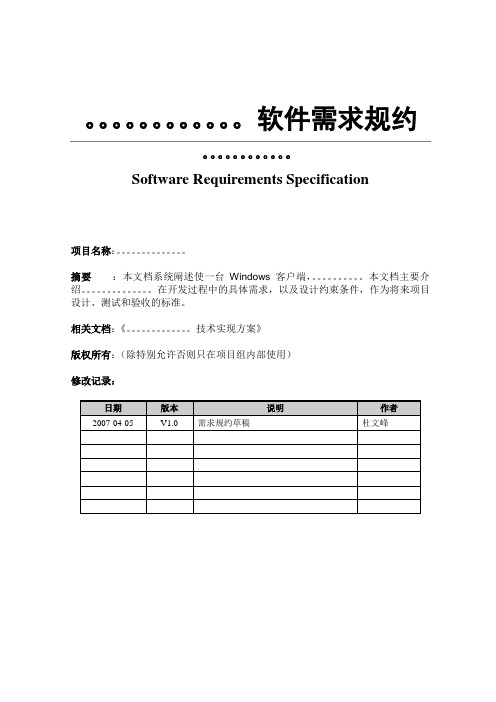
软件需求规约。
Software Requirements Specification项目名称:。
摘要:本文档系统阐述使一台Windows客户端,。
本文档主要介绍。
在开发过程中的具体需求,以及设计约束条件,作为将来项目设计、测试和验收的标准。
相关文档:《。
技术实现方案》版权所有:(除特别允许否则只在项目组内部使用)修改记录:目录1简介 (3)1.1目的 (3)1.2范围 (3)1.3定义、首字母缩写词和缩略语 (3)1.4参考资料 (3)2虚拟无线网卡开发背景 (3)2.1W INDOWS现有技术局限 (4)2.2演示代码技术局限 (4)2.3假设与依赖关系 (4)3技术具体需求 (4)3.1A NY W I-F I驱动模块管理和配置 (4)4设计约束 (5)4.1实现平台约束 (5)4.2技术实现约束 (5)4.3程序注释约束 (5)4.4文档模版约束 (6)4.5软件文档编写约束 (6)4.6时间约束 (6)5交付技术内容 (6)6时间安排 (6)1简介《。
技术》主要是针对Windows平台开发的一套无线虚拟网卡驱动程序。
,发送。
1.1 目的本文档主要规。
》在设计和开发过程中涉及到的技术需求、设计约束,并且该文档作为将来验收项目的根据,将与外包合同一起交接给合作方和我方技术开发人员。
1.2 范围本文档主要涉。
要求和设计约束,以及通信组件和检查组件的开发内容和验证方式。
1.3 定义、首字母缩写词和缩略语以下仅仅解释本文特殊提到或临时命名的名词,关于802_11和其他技术通用名词请参照相关文档:(4)WDK: 这是Microsoft在最近推出的一个DDK的开发工具集合和相关类库,在我们的开发过程中必须使用的工具集合。
(6)无线接入点AP(Access Point):无线接入点是指满足IEEE 802.11 b/g频谱规范,允许Wi-Fi无线终端接入并且访问网络的路由器产品。
1.4 参考资料2虚拟无线网卡开发背景无线网络环境是指由多个符合802.11b/g标准的无线接入点AP组成的无线覆盖范围。
需求规约全解
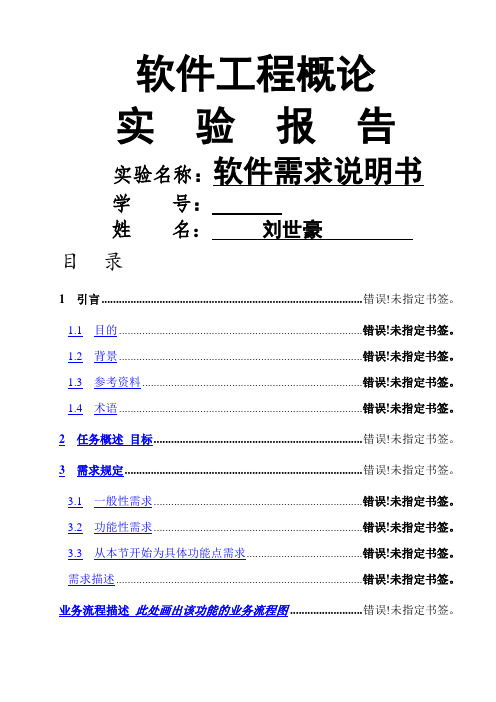
软件工程概论实验报告实验名称:软件需求说明书学号:姓名:刘世豪目录1引言.......................................................................................... 错误!未指定书签。
1.1目的.................................................................................... 错误!未指定书签。
1.2背景.................................................................................... 错误!未指定书签。
1.3参考资料............................................................................ 错误!未指定书签。
1.4术语.................................................................................... 错误!未指定书签。
2任务概述目标........................................................................ 错误!未指定书签。
3需求规定.................................................................................. 错误!未指定书签。
3.1一般性需求........................................................................ 错误!未指定书签。
3.2功能性需求........................................................................ 错误!未指定书签。
用例规约描述样板
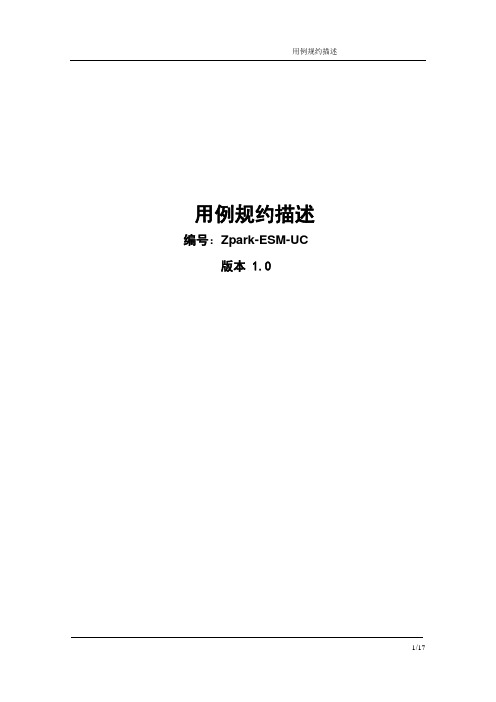
用例规约描述编号:Zpark-ESM-UC版本 1.0变更记录填表说明本文档的目的是依据《需求规格说明书》和系统原型,建立用例模型,并对用例模型进行具体描述。
用例规约描述是面向对象分析和设计的重要步骤。
用例规约描述需要进行评审。
1引言文档(《用例规约描述文档》)是描述项目小组对项目进行需求分析得到的关于用户和系统之间交互作用的文本性描述文档。
1.1目的用例是关于用户和系统之间相互作用的文本性描述,从外部角度描述系统的行为,表达系统应该做什么。
本文档通过用例规约描述,来进一步说明该系统需求,是下一阶段系统设计的基础,也是测试用例的重要依据。
1.2定义1.3概述ESM用来对企业员工薪酬进行管理,主要功能包括薪酬结构定义、组织结构定义、薪酬数据填写、薪酬审批、薪酬统计报表。
ESM包括四种角色(Actor):1.普通用户(User)普通用户指的是ESM系统中不具有管理、审批职能的用户,仅能够查看本人薪酬相关信息。
其对应的操作如图1所示。
图12.薪酬管理专员(SM)薪酬管理专员负责定义企业薪酬结构,并负责员工薪酬的审批。
其操作如图2所示。
图23.经理(Manager)经理指企业各级部门的负责人。
最基层的经理负责填写本部门员工的本月薪酬数据,包括基本工资、扣款、奖金或补贴。
上级经理负责审批。
其操作如图3所示。
图34.超级用户(SuperUser)超级用户负责创建企业组织结构,导入员工信息,系统用户管理。
其操作如图4所示。
图42用例描述2.1组织结构管理模块2.1.1建立新岗位用例规约:图ESM-ZZJG-1 岗位信息查询页面图ESM-ZZJG-2 岗位信息页面图ESM-ZZJG-32.1.2删除岗位用例规约:图ESM-ZZJG-42.1.3查询岗位用例规约:2.1.4更新岗位用例规约:图ESM-ZZJG-52.1.5添加岗位上下级关系用例规约:图ESM-ZZJG-6图ESM-ZZJG-72.1.6删除岗位上下级关系用例规约:ESM-ZZJG-8ESM-ZZJG-92.1.7查询岗位上下级关系用例规约:ESM-ZZJG-10ESM-ZZJG-112.2员工信息管理模块。
!!X系统需求规约说明书模板(最新版)

毕业设计管理系统软件需求规约说明书福建师范大学软件学院2014年6月目录1简介....................................................................................................... 错误!未定义书签。
1.1目的 ................................................................................................ 错误!未定义书签。
1.2范围 ................................................................................................ 错误!未定义书签。
1.3定义、首字母缩写词和缩略语 .................................................... 错误!未定义书签。
1.4参考资料 ........................................................................................ 错误!未定义书签。
2项目概述............................................................................................... 错误!未定义书签。
2.1产品功能 ........................................................................................ 错误!未定义书签。
2.3用户特点 ........................................................................................ 错误!未定义书签。
需求规约_模板

ATM需求规约模板
1 引言
1.1目的
为了明确用户的需求并较好的与开发人员进行沟通,使用户与开发人员双方…….
1.2背景
随着计算机技术的发展,日常生活中人们越来越多的使用ATM来进行存钱取钱等银行业务的操作……..
1.3 参考资料
……..
1.4术语
ATM :Auto Teller Machine,分为两部分组成。
一部分是ATM服务器,另一部分是ATM终端。
终端负责和银行卡持有者进行交互,ATM服务器负责处理交易。
一个ATM服务器可以同时连接多个ATM终端。
……..
2 项目概述
2.1总体功能描述
这个项目的开发是为银行提供一套高效稳定可靠的终端服务平台,为储户登录,存款,取款,查询等操作提供便利……..
//该系统要实现那些功能,请画一个功能简图
2.2一般约束
主要讲在开发时间、经费、设备、人员等有哪些要求约束限制等。
3需求说明
3.1 基本描述
功能上的描述和用户使用该系统流程上的描述……..
3.1.1用户信息
用户信息分为二部分:储户信息,管理员信息。
储户信息:…….
管理员信息:…….
3.1.2交易信息
卡信息:卡号,账号,密码,卡类型,卡金额
交易流水信息:…….
3.2 具体功能需求分析
……. (写需求用例)
3.3 性能需求
如果交易中响应时间超过30秒,系统提示“操作已过时”,自动退出本系统。
…….
3.4对输入输出的规定
密码:由用户设置的一个6位整数。
…….
3.5 其他专门的要求
易用性:…….
安全性:…….
…….。
需求规约模板全解
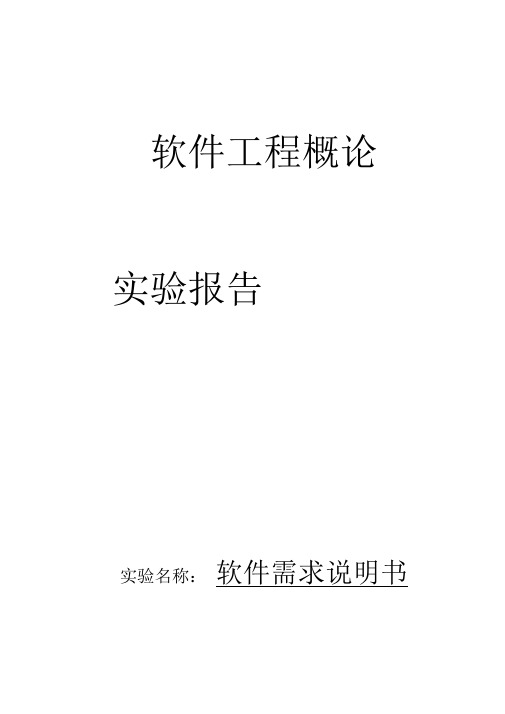
软件工程概论实验报告实验名称:软件需求说明书学号:________ 2014202107 _______目录1 引言 (4)1.1 目的 (4)1.2背景 (4)1.3 参考资料 (4)1.4 术语 (5)2任务概述目标 (6)3 需求规定 (8)3.1 一般性需求 (8)3.2 功能性需求 (8)3.3 从本节开始为具体功能点需求 (8)需求描述 (8)业务流程描述此处画出该功能的业务流程图 (9)数据描述 (9)3.4 系统安全性的要求 (11)4 运行环境规定 (12)4.1 运行环境 (12)4.2 接口 (12)5 遗留问题 (12)6 项目非技术需求 (13)引言目的本要求规格说明书对学校教材购销系统进行简单的分析,给出了系统的数据流图。
系统主要用户是学生,教师和教材工作人员,加深与用户间的交流,在功能与系统界面上与用户达成一致的看法,以便于开发出用户满意的系统。
背景名称:学校教材订购系统(School materials ordering system )预期读者:学生,教师,教材整理工作者以及对软件开发过程中文档编写格式不熟悉的初学者。
适用范围:学校教材购销系统是为高等院校开发的,用于日常的教材管理,包括销售与采购。
提供数字化的管理,提高学校教材管理部门的工作效率。
参考资料术语任务概述随着高校办学规模的扩展,管理方式和管理效率的矛盾日渐突出。
在教材购销方面,手工管理方式和文档系统管理方式在管理质量和管理效率上,从根本上不能适应大规模的管理要求。
而随着计算机科学的发展与进步,计算机科学管理方式,不管在管理效率还是在管理质量上都逐步显示出了它的可靠性和优越性。
而且计算机管理在人力、物力等资源方面都比以前的管理模式要有大的节省。
计算机管理正以它自身的优越性成为管理模式中的主流。
教材购销管理系统采用计算机管理模式的必然性也在与此!本系统以学校为背景,在认真调研和分析了学校订购教材的现状之后,根据学生,教师和教材工作人员的需求和各个功能的关系,做出了积极的设计方案。
需求规约模板全解

软件工程概论实验报告实验名称:软件需求说明书学号:2014202107姓名:刘世豪目录1引言 (4)1.1目的 (4)1.2背景 (4)1.3参考资料 (4)1.4术语 (5)2任务概述目标 (6)3需求规定 (8)3.1一般性需求 (8)3.2功能性需求 (8)3.3从本节开始为具体功能点需求 (8)需求描述 (8)业务流程描述此处画出该功能的业务流程图 (9)数据描述 (9)3.4系统安全性的要求 (11)4运行环境规定 (12)4.1运行环境 (12)4.2接口 (12)5遗留问题 (12)6项目非技术需求 (12)引言目的本要求规格说明书对学校教材购销系统进行简单的分析,给出了系统的数据流图。
系统主要用户是学生,教师和教材工作人员,加深与用户间的交流,在功能与系统界面上与用户达成一致的看法,以便于开发出用户满意的系统。
背景名称:学校教材订购系统(School materials ordering system)预期读者:学生,教师,教材整理工作者以及对软件开发过程中文档编写格式不熟悉的初学者。
适用范围:学校教材购销系统是为高等院校开发的,用于日常的教材管理,包括销售与采购。
提供数字化的管理,提高学校教材管理部门的工作效率。
参考资料术语任务概述随着高校办学规模的扩展,管理方式和管理效率的矛盾日渐突出。
在教材购销方面,手工管理方式和文档系统管理方式在管理质量和管理效率上,从根本上不能适应大规模的管理要求。
而随着计算机科学的发展与进步,计算机科学管理方式,不管在管理效率还是在管理质量上都逐步显示出了它的可靠性和优越性。
而且计算机管理在人力、物力等资源方面都比以前的管理模式要有大的节省。
计算机管理正以它自身的优越性成为管理模式中的主流。
教材购销管理系统采用计算机管理模式的必然性也在与此!本系统以学校为背景,在认真调研和分析了学校订购教材的现状之后,根据学生,教师和教材工作人员的需求和各个功能的关系,做出了积极的设计方案。
需求规约-企业人力资源管理系统

需求规约(企业人力资源管理系统)版权所有,翻版必究目录1引言 (4)1.1目的 (4)1.2背景 (4)1.3参考资料 (4)1.4术语 (4)2任务概述 (4)2.1目标 (4)3需求规定 (5)3.1一般性需求 (5)3.2功能性需求 (5)3.2.1角色说明 (5)3.2.2整体业务流程描述 (6)3.2.3组织结构管理操作流程描述 (7)3.2.4招聘子系统操作流程描述 (7)3.2.5人员配置操作流程描述 (8)3.2.6薪酬管理操作流程描述 (8)3.2.7系统管理操作流程描述 (8)4具体功能点需求 (8)4.1组织结构模块 (8)4.1.1公司管理模块 (8)4.1.2组织结构图管理模块 (9)4.1.3岗位管理模块 (11)4.1.4编制管理模块 (12)4.2招聘模块 (13)4.2.1招聘渠道管理模块 (14)4.2.2招聘需求管理模块 (15)4.2.3招聘活动管理模块 (16)4.2.4新建应聘者管理模块 (18)4.2.5应聘者管理模块 (20)4.2.6人才库管理模块 (22)4.3人员配置模块 (23)4.3.1员工入职管理模块 (23)4.3.2试用期管理模块 (26)4.3.3人员调动管理模块 (27)4.3.4员工离职管理模块 (30)4.3.5员工信息管理模块 (31)4.4薪酬管理模块 (32)4.4.1工资项目管理模块 (32)4.4.2固定工资管理模块 (34)4.4.3导入项目数据录入模块 (35)4.4.4工资结算管理模块 (36)4.4.5报表管理 (37)4.5系统管理模块 (38)4.5.1权限管理模块 (38)4.5.2角色管理模块 (40)4.5.3用户管理模块 (41)4.5.4系统登录/注销模块 (42)4.5.5日志管理模块 (44)5附录 (44)5.1系统安全性的要求 (44)5.1.1数据存储安全 (44)5.1.2访问控制安全 (44)5.1.3网络传输安全 (44)5.1.4应用系统审计 (45)5.1.5系统约束 (45)5.1.6其他专门要求 (45)6运行环境规定 (45)6.1运行环境 (45)6.1.1软件环境 (45)6.1.2硬件环境 (45)6.2接口 (45)7遗留问题 (45)8项目非技术需求 (45)1引言1.1 目的本需求规约文档的目的是对《企业人力资源管理系统》的软件需求进行说明描述,并为软件开发后续阶段提供指导和说明。
2用户需求规约书-模板
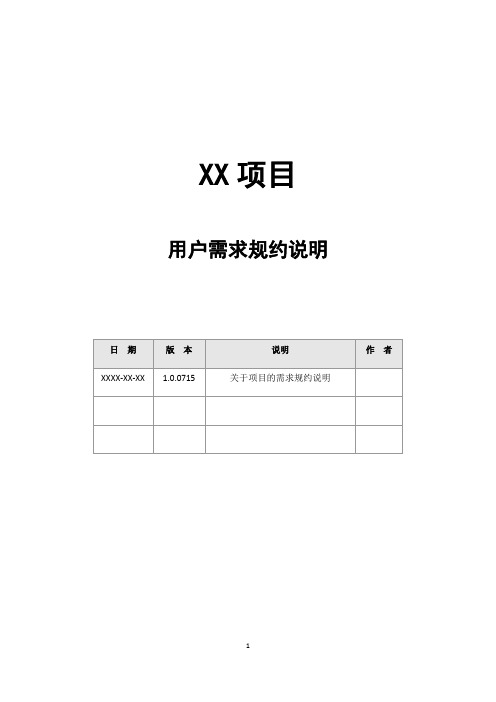
XX项目用户需求规约说明目录1 阅读目的 (3)2术语定义 (3)3用户类别 (3)3.1管理员 (3)4约束条件 (3)5需求清单 (4)5.1功能需求 (4)5.1.1管理员 (4)5.2非功能需求 (4)可用性 (4)可靠性 (5)性能 (5)可支持性 (5)设计约束 (5)安全性 (5)1 阅读目的通过阅读需求规约文档,对项目的用户类别、约束情况和需求有个整体的了解,并从中提取出详细的需求清单,记录在需求矩阵等相关文档中。
2术语定义(在此应对角色以及后续提到的一些术语给出说明。
)3用户类别本项目共分4类用户,分别为管理员、匿名用户、教师用户和学生用户。
各类用户的功能简述如下。
3.1管理员负责添加新用户和删除用户,设置和修改用户使用期限,重设用户密码,允许修改自己密码。
(其他用户功能略)4约束条件针对各类用户的约束条件如下:(1)系统只有一个管理员用户(2)只有管理员才能添加和删除用户(其他用户功能略)5需求清单5.1功能需求针对各类用户的功能需求概述如下。
5.1.1管理员管理员用户的用户功能需求清单如下表所示。
(其他用户需求略)5.2非功能需求可用性(1)学生可以方便的使用各种教学资源;(2)学生和教师可以随时修改个人密码。
可靠性(1)支持7*24小时的服务;(2)故障恢复时间为1小时。
性能(1)页面响应时间应该在3秒以内,最长不能超过6秒;(2)系统可同时容纳500个客户在线访问。
可支持性本系统为B/S结构型的应用程序,只需在服务器端进行部署,客户端通过浏览器就可访问。
因此,当程序有更改时只需要对服务器端更新即可,用户自动访问到最新版本的应用程序。
设计约束要求采用 2.0技术平台,编程语言为C#,后台数据库为MS SQL SERVER 2005,系统架构采用三层架构,并且按照微软企业级架构标准进行程序的开发工作。
安全性(1)对于重要数据(比如用户密码)进行不可逆加密,防止泄露;(2)在与数据库交互中,不使用SQL拼接方式,全部使用存储过程,有效杜绝了SQL注入;(3)分别为每类角色设置具有访问不同资源的权限。
system requirement specification 系统需求分析模版.doc
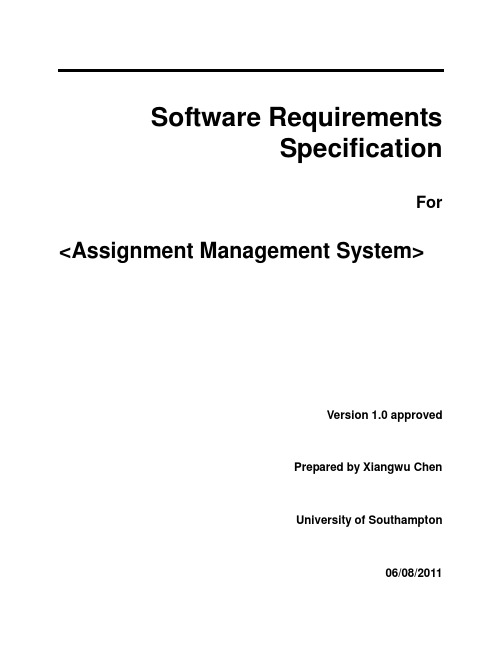
Software RequirementsSpecificationFor <Assignment Management System>Version 1.0 approvedPrepared by Xiangwu ChenUniversity of Southampton06/08/2011Software Requirements Specification for Assignment Management System Page iiTable of ContentsTable of Contents (ii)Revision History (ii)1. Introduction (1)1.1 Purpose (1)1.2 Document Conventions (1)1.3 Intended Audience and Reading Suggestions (1)1.4 Project Scope (1)1.5 References (1)2. Overall Description (2)2.1 Product Perspective (2)2.2 Product Features (2)2.3 User Classes and Characteristics (2)2.4 Operating Environment (2)2.5 Design and Implementation Constraints (2)2.6 User Documentation (2)2.7 Assumptions and Dependencies (3)3. System Features (3)3.1 System Feature 1 (3)3.2 System Feature 2 (and so on) (4)4. External Interface Requirements (4)4.1 User Interfaces (4)4.2 Hardware Interfaces (4)4.3 Software Interfaces (4)4.4 Communications Interfaces (4)5. Other Nonfunctional Requirements (5)5.1 Performance Requirements (5)5.2 Safety Requirements (5)5.3 Security Requirements (5)5.4 Software Quality Attributes (5)6. Other Requirements (5)Appendix A: Glossary (5)Appendix B: Analysis Models (6)Appendix C: Issues List (6)Revision History1.Introduction1.1Purpose<Identify the product whose software requirements are specified in this document, including the revision or release number. Describe the scope of the product that is covered by this SRS, particularly if this SRS describes only part of the system or a single subsystem.>1.2Document Conventions<Describe any standards or typographical conventions that were followed when writing this SRS, such as fonts or highlighting that have special significance. For example, state whether priorities for higher-level requirements are assumed to be inherited by detailed requirements, or whether every requirement statement is to have its own priority.>1.3Intended Audience and Reading Suggestions<Describe the different types of reader that the document is intended for, such as developers, project managers, marketing staff, users, testers, and documentation writers. Describe what the rest of this SRS contains and how it is organized. Suggest a sequence for reading the document, beginning with the overview sections and proceeding through the sections that are most pertinent to each reader type.>1.4Project Scope<Provide a short description of the software being specified and its purpose, including relevant benefits, objectives, and goals. Relate the software to corporate goals or business strategies. If a separate vision and scope document is available, refer to it rather than duplicating its contents here. An SRS that specifies the next release of an evolving product should contain its own scope statement as a subset of the long-term strategic product vision.>1.5References<List any other documents or Web addresses to which this SRS refers. These may include user interface style guides, contracts, standards, system requirements specifications, use case documents, or a vision and scope document. Provide enough information so that the reader could access a copy of each reference, including title, author, version number, date, and source or location.>2.Overall Description2.1Product Perspective<Describe the context and origin of the product being specified in this SRS. For example, state whether this product is a follow-on member of a product family, a replacement for certain existing systems, or a new, self-contained product. If the SRS defines a component of a larger system, relate the requirements of the larger system to the functionality of this software and identify interfaces between the two. A simple diagram that shows the major components of the overall system, subsystem interconnections, and external interfaces can be helpful.>2.2Product Features<Summarize the major features the product contains or the significant functions that it performs or lets the user perform. Details will be provided in Section 3, so only a high level summary is needed here. Organize the functions to make them understandable to any reader of the SRS. A picture of the major groups of related requirements and how they relate, such as a top level data flow diagram or a class diagram, is often effective.>2.3User Classes and Characteristics<Identify the various user classes that you anticipate will use this product. User classes may be differentiated based on frequency of use, subset of product functions used, technical expertise, security or privilege levels, educational level, or experience. Describe the pertinent characteristics of each user class. Certain requirements may pertain only to certain user classes. Distinguish the favored user classes from those who are less important to satisfy.>2.4Operating Environment<Describe the environment in which the software will operate, including the hardware platform, operating system and versions, and any other software components or applications with which it must peacefully coexist.>2.5Design and Implementation Constraints<Describe any items or issues that will limit the options available to the developers. These might include: corporate or regulatory policies; hardware limitations (timing requirements, memory requirements); interfaces to other applications; specific technologies, tools, and databases to be used; parallel operations; language requirements; communications protocols; security considerations; design conventions or programming standards (for example, if the customer’s organization will be responsible for maintaining the delivered software).>2.6User Documentation<List the user documentation components (such as user manuals, on-line help, and tutorials) that will be delivered along with the software. Identify any known user documentation delivery formats or standards.>2.7Assumptions and Dependencies<List any assumed factors (as opposed to known facts) that could affect the requirements stated in the SRS. These could include third-party or commercial components that you plan to use, issues around the development or operating environment, or constraints. The project could be affected if these assumptions are incorrect, are not shared, or change. Also identify any dependencies the project has on external factors, such as software components that you intend to reuse from another project, unless they are already documented elsewhere (for example, in the vision and scope document or the project plan).>3.System Features<This template illustrates organizing the functional requirements for the product by system features, the major services provided by the product. You may prefer to organize this section by use case, mode of operation, user class, object class, functional hierarchy, or combinations of these, whatever makes the most logical sense for your product.>3.1System Feature 1<Don’t really say “System Feature 1.” State the feature name in just a few words.>3.1.1 Description and Priority<Provide a short description of the feature and indicate whether it is of High, Medium,or Low priority. You could also include specific priority component ratings, such asbenefit, penalty, cost, and risk (each rated on a relative scale from a low of 1 to ahigh of 9).>3.1.2 Stimulus/Response Sequences<List the sequences of user actions and system responses that stimulate thebehavior defined for this feature. These will correspond to the dialog elementsassociated with use cases.>3.1.3 Functional Requirements<Itemize the detailed functional requirements associated with this feature. These arethe software capabilities that must be present in order for the user to carry out theservices provided by the feature, or to execute the use case. Include how theproduct should respond to anticipated error conditions or invalid inputs.Requirements should be concise, complete, unambiguous, verifiable, and necessary.Use “TBD” as a placeholder to indicate when necessary information is not yetavailable.><Each requirement should be uniquely identified with a sequence number or ameaningful tag of some kind.>REQ-1:REQ-2:3.2System Feature 2 (and so on)4.External Interface Requirements4.1User Interfaces<Describe the logical characteristics of each interface between the software product and the users. This may include sample screen images, any GUI standards or product family style guides that are to be followed, screen layout constraints, standard buttons and functions (e.g., help) that will appear on every screen, keyboard shortcuts, error message display standards, and so on. Define the software components for which a user interface is needed. Details of the user interface design should be documented in a separate user interface specification.>4.2Hardware Interfaces<Describe the logical and physical characteristics of each interface between the software product and the hardware components of the system. This may include the supported device types, the nature of the data and control interactions between the software and the hardware, and communication protocols to be used.>4.3Software Interfaces<Describe the connections between this product and other specific software components (name and version), including databases, operating systems, tools, libraries, and integrated commercial components. Identify the data items or messages coming into the system and going out and describe the purpose of each. Describe the services needed and the nature of communications. Refer to documents that describe detailed application programming interface protocols. Identify data that will be shared across software components. If the data sharing mechanism must be implemented in a specific way (for example, use of a global data area in a multitasking operating system), specify this as an implementation constraint.>4.4Communications Interfaces<Describe the requirements associated with any communications functions required by this product, including e-mail, web browser, network server communications protocols, electronic forms, and so on. Define any pertinent message formatting. Identify any communication standards that will be used, such as FTP or HTTP. Specify any communication security or encryption issues, data transfer rates, and synchronization mechanisms.>5.Other Nonfunctional Requirements5.1Performance Requirements<If there are performance requirements for the product under various circumstances, state them here and explain their rationale, to help the developers understand the intent and make suitable design choices. Specify the timing relationships for real time systems. Make such requirements as specific as possible. You may need to state performance requirements for individual functional requirements or features.>5.2Safety Requirements<Specify those requirements that are concerned with possible loss, damage, or harm that could result from the use of the product. Define any safeguards or actions that must be taken, as well as actions that must be prevented. Refer to any external policies or regulations that state safety issues that affect the product’s design or use. Define any safety certifications that must be satisfied.>5.3Security Requirements<Specify any requirements regarding security or privacy issues surrounding use of the product or protection of the data used or created by the product. Define any user identity authentication requirements. Refer to any external policies or regulations containing security issues that affect the product. Define any security or privacy certifications that must be satisfied.>5.4Software Quality Attributes<Specify any additional quality characteristics for the product that will be important to either the customers or the developers. Some to consider are: adaptability, availability, correctness, flexibility, interoperability, maintainability, portability, reliability, reusability, robustness, testability, and usability. Write these to be specific, quantitative, and verifiable when possible. At the least, clarify the relative preferences for various attributes, such as ease of use over ease of learning.>6.Other Requirements<Define any other requirements not covered elsewhere in the SRS. This might include database requirements, internationalization requirements, legal requirements, reuse objectives for the project, and so on. Add any new sections that are pertinent to the project.>Appendix A: Glossary<Define all the terms necessary to properly interpret the SRS, including acronyms and abbreviations. You may wish to build a separate glossary that spans multiple projects or the entire organization, and just include terms specific to a single project in each SRS.>Appendix B: Analysis Models<Optionally, include any pertinent analysis models, such as data flow diagrams, class diagrams, state-transition diagrams, or entity-relationship diagrams.>Appendix C: Issues List< This is a dynamic list of the open requirements issues that remain to be resolved, including TBDs, pending decisions, information that is needed, conflicts awaiting resolution, and the like.>。
软件需求规约模板

XXXXX公司项目名称软件需求规约用于<子系统或特性>版本 <1.0>修订历史记录目录1.简介41.1目的41.2范围41.3定义、首字母缩写词和缩略语41.4参考资料41.5概述42.整体说明43.具体需求53.1功能53.1.1<功能性需求一> 53.2可用性53.2.1<可用性需求一> 63.3可靠性63.3.1<可靠性需求一> 63.4性能63.4.1<性能需求一> 63.5可支持性73.5.1<可支持性需求一> 73.6设计约束73.6.1<设计约束一> 73.7联机用户文档和帮助系统需求73.8购买的构件73.9接口73.9.1用户界面73.9.2硬件接口73.9.3软件接口73.9.4通信接口83.10许可需求83.11法律、版权及其他声明83.12适用的标准84.支持信息8软件需求规约1.简介软件需求规约(SRS)的简介应提供整个SRS 的概述。
它应包括此 SRS的目的、范围、定义、首字母缩写词、缩略语、参考资料和概述。
][注:软件需求规约(SRS) 记录对系统或系统的一部分的完整软件需求。
以下是一个典型的SRS概述,用于以传统的自然语言风格表达需求而不涉及用例建模的项目。
它在一个文档中记录了所有的需求,而适用的部分可从补充规约(此后将不再需要)中插入。
对于涉及用例建模的SRS模板(由包含用例模型的用例、适用的补充规约及其他支持信息的包组成),请参见rup_SRS-uc.dot。
] [SRS 可能有许多不同的组织方式。
有关这些方式的进一步阐述以及SRS的其他结构组织方式,请参见 [IEEE830-1998]。
]1.1目的[阐明此SRS的目的。
SRS应详细地说明所确定的应用程序或子系统的外部行为。
它还要说明非功能性需求、设计约束以及提供完整、综合的软件需求说明所需的其他因素。
]1.2范围[简要说明此SRS适用的软件应用程序、特性或其他子系统分组、与其相关的用例模型,以及受到此文档影响的任何其他事物。
需求规约模板(SystemRequirementSpecification)
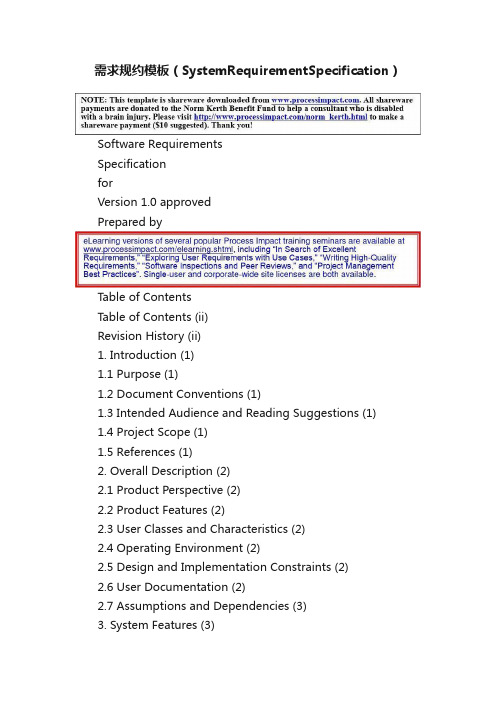
需求规约模板(SystemRequirementSpecification)Software RequirementsSpecificationforVersion 1.0 approvedPrepared byTable of ContentsTable of Contents (ii)Revision History (ii)1. Introduction (1)1.1 Purpose (1)1.2 Document Conventions (1)1.3 Intended Audience and Reading Suggestions (1) 1.4 Project Scope (1)1.5 References (1)2. Overall Description (2)2.1 Product Perspective (2)2.2 Product Features (2)2.3 User Classes and Characteristics (2)2.4 Operating Environment (2)2.5 Design and Implementation Constraints (2)2.6 User Documentation (2)2.7 Assumptions and Dependencies (3)3. System Features (3)3.1 System Feature 1 (3)3.2 System Feature 2 (and so on) (4)4. External Interface Requirements (4)4.1 User Interfaces (4)4.2 Hardware Interfaces (4)4.3 Software Interfaces (4)4.4 Communications Interfaces (4)5. Other Nonfunctional Requirements (5)5.1 Performance Requirements (5)5.2 Safety Requirements (5)5.3 Security Requirements (5)5.4 Software Quality Attributes (5)6. Other Requirements (5)Appendix A: Glossary (5)Appendix B: Analysis Models (6)Appendix C: Issues List (6)Revision History1.Introduction1.1Purpose1.2Document Conventions1.3Intended Audience and Reading Suggestions 1.4Project Scope1.5References2.Overall Description2.1Product Perspective2.2Product Features2.3User Classes and Characteristics2.4Operating Environment2.5Design and Implementation Constraints2.6User Documentation2.7Assumptions and Dependencies3.System Features3.1System Feature 13.1.1 Description and Priority<="" of="" p="" short="" the="" whether="">or Low priority. You could also include specific priority component ratings, such asbenefit, penalty, cost, and risk (each rated on a relative scale from a low of 1 to ahigh of 9).>3.1.2 Stimulus/Response Sequences<="" user="">behavior defined for this feature. These will correspond to the dialog elementsassociated with use cases.>3.1.3 Functional Requirements<="" associated="" bdsfid="172" detailed="" feature.="" functional="" p="" requirements="" the="" these="" this="" with="">the software capabilities that must be present in order for the user to carry out theservices provided by the feature, or to execute the use case. Include how theproduct should respond to anticipated error conditions or invalid inputs.Requirements should be concise, complete, unambiguous, verifiable, and necessary.Use “TBD” as a placeholder to indicate when necessaryinformation is not yetavailable.><="" bdsfid="180" be="" identified="" number="" or="" p="" requirement="" sequence="" should="" uniquely="" with="">meaningful tag of some kind.>REQ-1:REQ-2:3.2System Feature 2 (and so on)4.External Interface Requirements4.1User Interfaces4.2Hardware Interfaces4.3Software Interfaces4.4Communications Interfaces5.Other Nonfunctional Requirements5.1Performance Requirements5.2Safety Requirements5.3Security Requirements5.4Software Quality Attributes6.Other RequirementsAppendix A: GlossaryAppendix B: Analysis ModelsAppendix C: Issues List< This is a dynamic list of the open requirements issues that remain to be resolved, including TBDs, pending decisions, information that is needed, conflicts awaiting resolution, and the like.>。
需求规格说明书

需求规格说明书完成人:1.概述(Summary)1.1项目的目的与目标(Purpose and Aim of Project)项目的目的是对开发本系统意图的总概括。
项目的目标是将目的细化后的具体描述。
项目目标应是明确的、可度量的、可以达到的, 项目的范围应能确保项目的目标可以达到。
对于项目的目标可以逐步细化,以便与系统的需求建立对应关系,检查系统的功能是否覆盖了系统目标。
1.2 术语定义(Terms Glossary)将该用户需求报告中的术语、缩写进行定义, 包括用户应用领域与计算机领域的术语与缩写等。
1.3 相关文档(Related Documents)说明用户需求报告的变更,以及可能受变更影响的其他相关文档,如:项目开发计划和设计说明书。
2.问题初始分析(Early Analysis)2.1 场景描述(Scene Description)自然语言描述2.2 初始功能提取(Early Function Distill)自然语言描述3.目标系统功能需求(Function of Target System)3.1 功能需求分析(Function Analysis)创建用例模型与域模型,要求采用用例表进行用例规约描述,必要时采用活动图进行检验。
3.2 功能需求点列表(Function List)在功能需求分析完成后,要详细列出用户需求功能点列表,提供给后续设计、编程、测试中使用,更是为了用户测试验收中使用。
功能需求点列表的格式,如表2-1所示。
表2-1 功能需求点列表4.目标系统性能需求(Performance of Target System)4.1 时间要求(Time Request)如:(1)响应时间,如查询的最长等待时间。
(2)更新处理时间,如记账的最长时间。
(3)数据的转换和传送时间,如远程数据传输的时间要求。
(4)解题时间。
4.2 空间要求(Space Request)如:(1)支持的终端数。
面向过程软件需求规约——例子
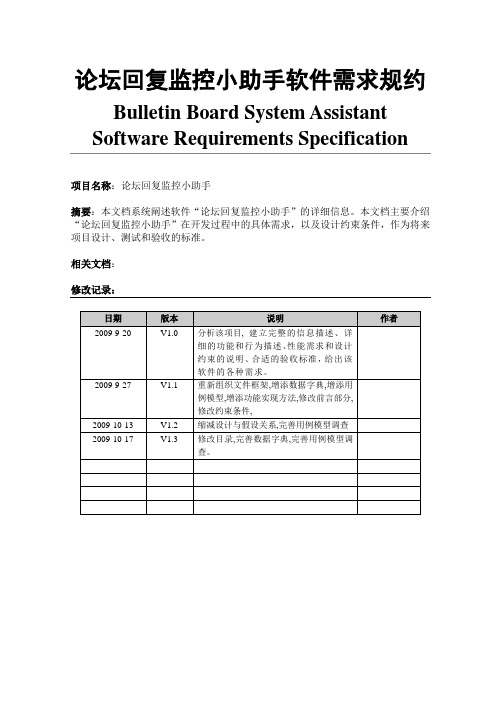
论坛回复监控小助手软件需求规约Bulletin Board System Assistant Software Requirements Specification项目名称:论坛回复监控小助手摘要:本文档系统阐述软件“论坛回复监控小助手”的详细信息。
本文档主要介绍“论坛回复监控小助手”在开发过程中的具体需求,以及设计约束条件,作为将来项目设计、测试和验收的标准。
相关文档:修改记录:目录1简介 (3)1.1目的 (3)1.2范围 (3)1.3定义、首字母缩写词和缩略语 (4)1.4参考资料 (4)1.5概述 (4)2整体说明 (5)2.1用例模型调查 (5)2.2假设与依赖关系 (9)3具体需求 (10)3.1用例报告 (10)3.2补充需求 (10)3.3数据字典 (11)3.3.1设置监控论坛 (11)3.3.2选择实时监控论坛 (11)3.3.3查看信息 (12)3.3.4登录验证 (14)3.3.5结构层次图 (15)4设计约束 (15)4.1实现平台约束 (15)4.2技术实现约束 (16)4.3程序注释约束 (16)4.4文档模版约束 (16)4.5软件文档编写约束 (16)4.6时间约束 (16)5交付技术内容 (16)6时间安排 (16)1简介《论坛回复监控小助手软件需求规约》主要是描述基于Windows平台开发的一个自动跟踪监控论坛上所发帖子的回复情况的软件完整需求,其主要目的为对“论坛回复监控小助手”软件进行定义,详尽说明该软件的需求,阐述开发者对软件“论坛回复监控小助手”的初步设想,并划分的各功能模块等以及各模块的实体图等。
《论坛回复监控小助手软件需求规约》在整个项目开发阶段中控制系统的演进。
在“前景”文档中添加新特性或修改特性的同时,将在《论坛回复监控小助手软件需求规约》中详细说明这些特性。
下列人员使用软件需求规约:1、系统分析员创建并维护前景和补充规约,它们将用作对《论坛回复监控小助手软件需求规约》的输入,并充当系统分析员、客户和其他开发人员之间的交流媒介。
- 1、下载文档前请自行甄别文档内容的完整性,平台不提供额外的编辑、内容补充、找答案等附加服务。
- 2、"仅部分预览"的文档,不可在线预览部分如存在完整性等问题,可反馈申请退款(可完整预览的文档不适用该条件!)。
- 3、如文档侵犯您的权益,请联系客服反馈,我们会尽快为您处理(人工客服工作时间:9:00-18:30)。
Software RequirementsSpecificationfor<Project>Version 1.0 approvedPrepared by <author><organization><date created>Table of ContentsTable of Contents (ii)Revision History (ii)1. Introduction (1)1.1 Purpose (1)1.2 Document Conventions (1)1.3 Intended Audience and Reading Suggestions (1)1.4 Project Scope (1)1.5 References (1)2. Overall Description (2)2.1 Product Perspective (2)2.2 Product Features (2)2.3 User Classes and Characteristics (2)2.4 Operating Environment (2)2.5 Design and Implementation Constraints (2)2.6 User Documentation (2)2.7 Assumptions and Dependencies (3)3. System Features (3)3.1 System Feature 1 (3)3.2 System Feature 2 (and so on) (4)4. External Interface Requirements (4)4.1 User Interfaces (4)4.2 Hardware Interfaces (4)4.3 Software Interfaces (4)4.4 Communications Interfaces (4)5. Other Nonfunctional Requirements (5)5.1 Performance Requirements (5)5.2 Safety Requirements (5)5.3 Security Requirements (5)5.4 Software Quality Attributes (5)6. Other Requirements (5)Appendix A: Glossary (5)Appendix B: Analysis Models (6)Appendix C: Issues List (6)Revision History1.Introduction1.1Purpose<Identify the product whose software requirements are specified in this document, including the revision or release number. Describe the scope of the product that is covered by this SRS, particularly if this SRS describes only part of the system or a single subsystem.>1.2Document Conventions<Describe any standards or typographical conventions that were followed when writing this SRS, such as fonts or highlighting that have special significance. For example, state whether priorities for higher-level requirements are assumed to be inherited by detailed requirements, or whether every requirement statement is to have its own priority.>1.3Intended Audience and Reading Suggestions<Describe the different types of reader that the document is intended for, such as developers, project managers, marketing staff, users, testers, and documentation writers. Describe what the rest of this SRS contains and how it is organized. Suggest a sequence for reading the document, beginning with the overview sections and proceeding through the sections that are most pertinent to each reader type.>1.4Project Scope<Provide a short description of the software being specified and its purpose, including relevant benefits, objectives, and goals. Relate the software to corporate goals or business strategies. If a separate vision and scope document is available, refer to it rather than duplicating its contents here. An SRS that specifies the next release of an evolving product should contain its own scope statement as a subset of the long-term strategic product vision.>1.5References<List any other documents or Web addresses to which this SRS refers. These may include user interface style guides, contracts, standards, system requirements specifications, use case documents, or a vision and scope document. Provide enough information so that the reader could access a copy of each reference, including title, author, version number, date, and source or location.>2.Overall Description2.1Product Perspective<Describe the context and origin of the product being specified in this SRS. For example, state whether this product is a follow-on member of a product family, a replacement for certain existing systems, or a new, self-contained product. If the SRS defines a component of a larger system, relate the requirements of the larger system to the functionality of this software and identify interfaces between the two. A simple diagram that shows the major components of the overall system, subsystem interconnections, and external interfaces can be helpful.>2.2Product Features<Summarize the major features the product contains or the significant functions that it performs or lets the user perform. Details will be provided in Section 3, so only a high level summary is needed here. Organize the functions to make them understandable to any reader of the SRS. A picture of the major groups of related requirements and how they relate, such as a top level data flow diagram or a class diagram, is often effective.>2.3User Classes and Characteristics<Identify the various user classes that you anticipate will use this product. User classes may be differentiated based on frequency of use, subset of product functions used, technical expertise, security or privilege levels, educational level, or experience. Describe the pertinent characteristics of each user class. Certain requirements may pertain only to certain user classes. Distinguish the favored user classes from those who are less important to satisfy.>2.4Operating Environment<Describe the environment in which the software will operate, including the hardware platform, operating system and versions, and any other software components or applications with which it must peacefully coexist.>2.5Design and Implementation Constraints<Describe any items or issues that will limit the options available to the developers. These might include: corporate or regulatory policies; hardware limitations (timing requirements, memory requirements); interfaces to other applications; specific technologies, tools, and databases to be used; parallel operations; language requirements; communications protocols; security considerations; design conventions or programming standards (for example, if the customer’s organization will be responsible for maintaining the delivered software).>2.6User Documentation<List the user documentation components (such as user manuals, on-line help, and tutorials) that will be delivered along with the software. Identify any known user documentation delivery formats or standards.>2.7Assumptions and Dependencies<List any assumed factors (as opposed to known facts) that could affect the requirements stated in the SRS. These could include third-party or commercial components that you plan to use, issues around the development or operating environment, or constraints. The project could be affected if these assumptions are incorrect, are not shared, or change. Also identify any dependencies the project has on external factors, such as software components that you intend to reuse from another project, unless they are already documented elsewhere (for example, in the vision and scope document or the project plan).>3.System Features<This template illustrates organizing the functional requirements for the product by system features, the major services provided by the product. You may prefer to organize this section by use case, mode of operation, user class, object class, functional hierarchy, or combinations of these, whatever makes the most logical sense for your product.>3.1System Feature 1<Don’t really say “System Feature 1.” State the feature name in just a few words.>3.1.1 Description and Priority<Provide a short description of the feature and indicate whether it is of High, Medium,or Low priority. You could also include specific priority component ratings, such asbenefit, penalty, cost, and risk (each rated on a relative scale from a low of 1 to ahigh of 9).>3.1.2 Stimulus/Response Sequences<List the sequences of user actions and system responses that stimulate thebehavior defined for this feature. These will correspond to the dialog elementsassociated with use cases.>3.1.3 Functional Requirements<Itemize the detailed functional requirements associated with this feature. These arethe software capabilities that must be present in order for the user to carry out theservices provided by the feature, or to execute the use case. Include how theproduct should respond to anticipated error conditions or invalid inputs.Requirements should be concise, complete, unambiguous, verifiable, and necessary.Use “TBD” as a placeholder to indicate when necessary information is not yetavailable.><Each requirement should be uniquely identified with a sequence number or ameaningful tag of some kind.>REQ-1:REQ-2:3.2System Feature 2 (and so on)4.External Interface Requirements4.1User Interfaces<Describe the logical characteristics of each interface between the software product and the users. This may include sample screen images, any GUI standards or product family style guides that are to be followed, screen layout constraints, standard buttons and functions (e.g., help) that will appear on every screen, keyboard shortcuts, error message display standards, and so on. Define the software components for which a user interface is needed. Details of the user interface design should be documented in a separate user interface specification.>4.2Hardware Interfaces<Describe the logical and physical characteristics of each interface between the software product and the hardware components of the system. This may include the supported device types, the nature of the data and control interactions between the software and the hardware, and communication protocols to be used.>4.3Software Interfaces<Describe the connections between this product and other specific software components (name and version), including databases, operating systems, tools, libraries, and integrated commercial components. Identify the data items or messages coming into the system and going out and describe the purpose of each. Describe the services needed and the nature of communications. Refer to documents that describe detailed application programming interface protocols. Identify data that will be shared across software components. If the data sharing mechanism must be implemented in a specific way (for example, use of a global data area in a multitasking operating system), specify this as an implementation constraint.>4.4Communications Interfaces<Describe the requirements associated with any communications functions required by this product, including e-mail, web browser, network server communications protocols, electronic forms, and so on. Define any pertinent message formatting. Identify any communication standards that will be used, such as FTP or HTTP. Specify any communication security or encryption issues, data transfer rates, and synchronization mechanisms.>5.Other Nonfunctional Requirements5.1Performance Requirements<If there are performance requirements for the product under various circumstances, state them here and explain their rationale, to help the developers understand the intent and make suitable design choices. Specify the timing relationships for real time systems. Make such requirements as specific as possible. You may need to state performance requirements for individual functional requirements or features.>5.2Safety Requirements<Specify those requirements that are concerned with possible loss, damage, or harm that could result from the use of the product. Define any safeguards or actions that must be taken, as well as actions that must be prevented. Refer to any external policies or regulations that state safety issues that affect the product’s design or use. Define any safety certifications that must be satisfied.>5.3Security Requirements<Specify any requirements regarding security or privacy issues surrounding use of the product or protection of the data used or created by the product. Define any user identity authentication requirements. Refer to any external policies or regulations containing security issues that affect the product. Define any security or privacy certifications that must be satisfied.>5.4Software Quality Attributes<Specify any additional quality characteristics for the product that will be important to either the customers or the developers. Some to consider are: adaptability, availability, correctness, flexibility, interoperability, maintainability, portability, reliability, reusability, robustness, testability, and usability. Write these to be specific, quantitative, and verifiable when possible. At the least, clarify the relative preferences for various attributes, such as ease of use over ease of learning.>6.Other Requirements<Define any other requirements not covered elsewhere in the SRS. This might include database requirements, internationalization requirements, legal requirements, reuse objectives for the project, and so on. Add any new sections that are pertinent to the project.>Appendix A: Glossary<Define all the terms necessary to properly interpret the SRS, including acronyms and abbreviations. You may wish to build a separate glossary that spans multiple projects or the entire organization, and just include terms specific to a single project in each SRS.>Appendix B: Analysis Models<Optionally, include any pertinent analysis models, such as data flow diagrams, class diagrams, state-transition diagrams, or entity-relationship diagrams.>Appendix C: Issues List< This is a dynamic list of the open requirements issues that remain to be resolved, including TBDs, pending decisions, information that is needed, conflicts awaiting resolution, and the like.>。
